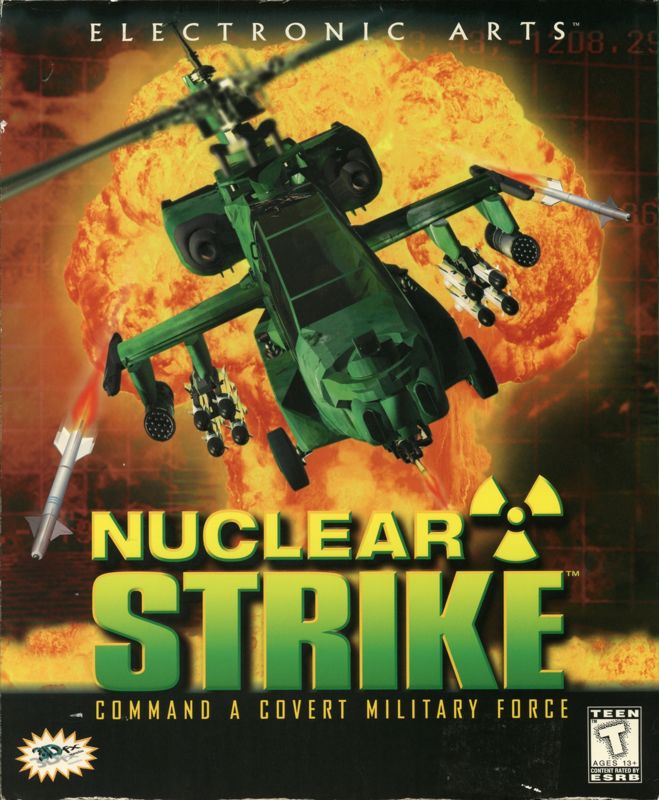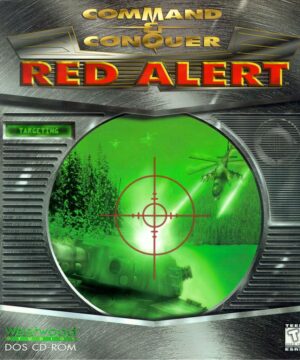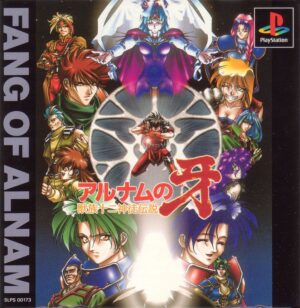Retro Replay Review
Gameplay
Nuclear Strike delivers an adrenaline-fueled mix of aerial and ground combat, putting you in the cockpit of the Super Apache helicopter and a handful of other vehicles. From the moment you lift off in Indocine’s dense jungles, the game keeps you on your toes with varied mission objectives—ranging from precision strikes on surface-to-air emplacements to rapid-response rescue operations under enemy fire. The control scheme feels intuitive, with dual analog input for flight maneuvers and target tracking, allowing you to switch seamlessly between Hellfire missiles, Sidewinders, and Hydra cannons as the situation demands.
(HEY YOU!! We hope you enjoy! We try not to run ads. So basically, this is a very expensive hobby running this site. Please consider joining us for updates, forums, and more. Network w/ us to make some cash or friends while retro gaming, and you can win some free retro games for posting. Okay, carry on 👍)
What truly stands out is the dynamic pacing of the missions. One moment you’re weaving through towering trees to destroy hidden anti-aircraft batteries, the next you’re scrambling across the open South China Sea in high-speed dogfights against jet fighters. The introduction of tanks and allied ground teams adds a welcome layer of strategy—sometimes you’ll need to call in a tank convoy to breach fortified bunkers before plunging back into the rotor wash of your Apache. This interplay between air and land combat keeps the experience fresh throughout the campaign.
AI behavior is challenging yet fair. Enemy pilots will attempt flanking maneuvers, while ground units spread out to avoid your explosive ordnance. Allied operatives occasionally radio in reinforcements, or provide vital intel on hidden targets, giving you a sense of participation in a broader military operation. Even on higher difficulty levels, you rarely feel overwhelmed, as long as you make smart use of your weapon inventory and stay aware of your radar at all times.
Graphics
For its time, Nuclear Strike’s visuals are remarkable. Environments are richly detailed, from the humid, overgrown foliage of Indochina to the storm-tossed waves of the South China Sea. Terrain textures hold up well, with convincing rock faces and muddy riverbanks that show scorch marks after a heavy ordnance run. The transition to the frigid, snow-laden landscapes of Siberia highlights a different artistic palette—the stark whites and grays punctuated by orange explosions against the horizon create striking visual contrasts.
The Super Apache and all enemy vehicles are modeled with surprising detail. You can make out individual rivets along the helicopter’s fuselage, and the glowing tips of a Sidewinder launch felt like a reward for a perfect lock-on. Explosions are bright and punchy, sending debris flying in every direction with satisfying physics-based shrapnel. Even the cockpit HUD is crisply rendered, with clear icons for weapon loadouts and a functional radar display that never feels tacked-on.
Performance-wise, the game remains smooth even when dozens of missiles light up the sky. Pop-in is minimal, and draw distance rarely hinders your situational awareness—an impressive technical achievement given the scope of the battlefields. Weather effects, such as drifting sandstorms or sudden rain showers over the China Sea, not only look great but also affect visibility, adding realism to the engagement without bogging down frame rates.
Story
Nuclear Strike picks up where Global Strike left off, sending you on a globe-spanning hunt for the diabolical Colonel LeMonde. This time, he’s teamed up with regional strongmen—Napoleon Hwong in the South China Sea and Kym Zung-Lee in North Korea—with a doomsday device capable of obliterating the ozone layer. The stakes are alarmingly high: a single nuclear warhead could irradiate the entire planet. This overarching threat lends urgency to every mission briefing, making each sortie feel like a critical piece of a global puzzle.
Cutscenes and radio chatter flesh out the personalities of both allies and adversaries. You grow to respect the steely determination of your fellow operatives, and you can’t help but feel a thrill when Intel confirms Colonel LeMonde’s next target. While the narrative occasionally leans on Cold War tropes, its pacing and international scope maintain a compelling momentum. By the time you’re storming North Korean strongholds or evading interceptor jets over Siberia’s tundra, the story’s do-or-die atmosphere is in full swing.
The dialogues are concise yet impactful, striking a balance between exposition and action. You never get bogged down in needless lore, but there’s enough context to understand why each mission exists and how it contributes to stopping a cataclysmic global event. This sense of purpose drives you forward, ensuring that each successful mission feels like a meaningful victory in the battle against a nuclear apocalypse.
Overall Experience
Nuclear Strike is a standout title for fans of vehicle-based combat and strategic mission design. The robust gameplay mechanics, varied mission environments, and high-stakes narrative combine to create an experience that feels both epic and personal. Whether you’re conducting a stealthy nighttime raid or engaging in all-out war above the clouds, the game delivers a sustained sense of excitement from start to finish.
The technical polish is impressive, from stable frame rates during large-scale firefights to detailed environmental effects that change with each theater of war. Even years after its release, Nuclear Strike holds up as a benchmark for helicopter action games, offering both the accessibility casual players appreciate and the depth hardcore enthusiasts demand. The soundtrack and sound effects elevate the tension further, with whirring rotor sounds and explosive impacts that resonate through your speakers.
At its core, Nuclear Strike satisfies a primal urge for high-octane warfare without sacrificing thoughtful mission variety or narrative cohesion. It’s a worthy successor in the Strike series and a must-play for anyone who enjoys orchestrating precision attacks from the pilot’s seat. If you’re on the fence, know that this game combines solid mechanics, memorable set pieces, and a globe-trotting storyline into one thoroughly engaging package.
 Retro Replay Retro Replay gaming reviews, news, emulation, geek stuff and more!
Retro Replay Retro Replay gaming reviews, news, emulation, geek stuff and more!









Reviews
There are no reviews yet.